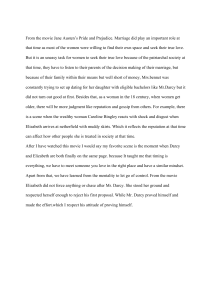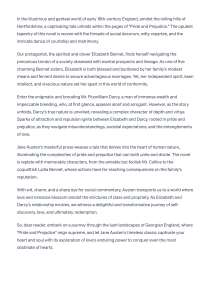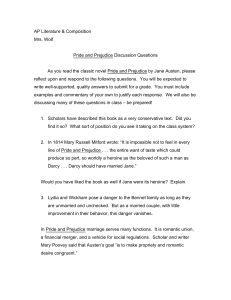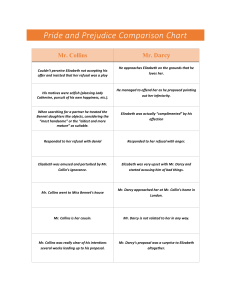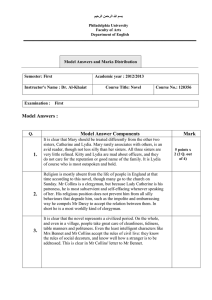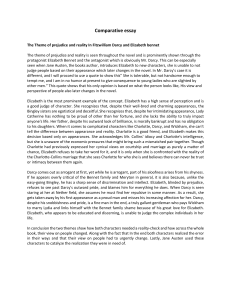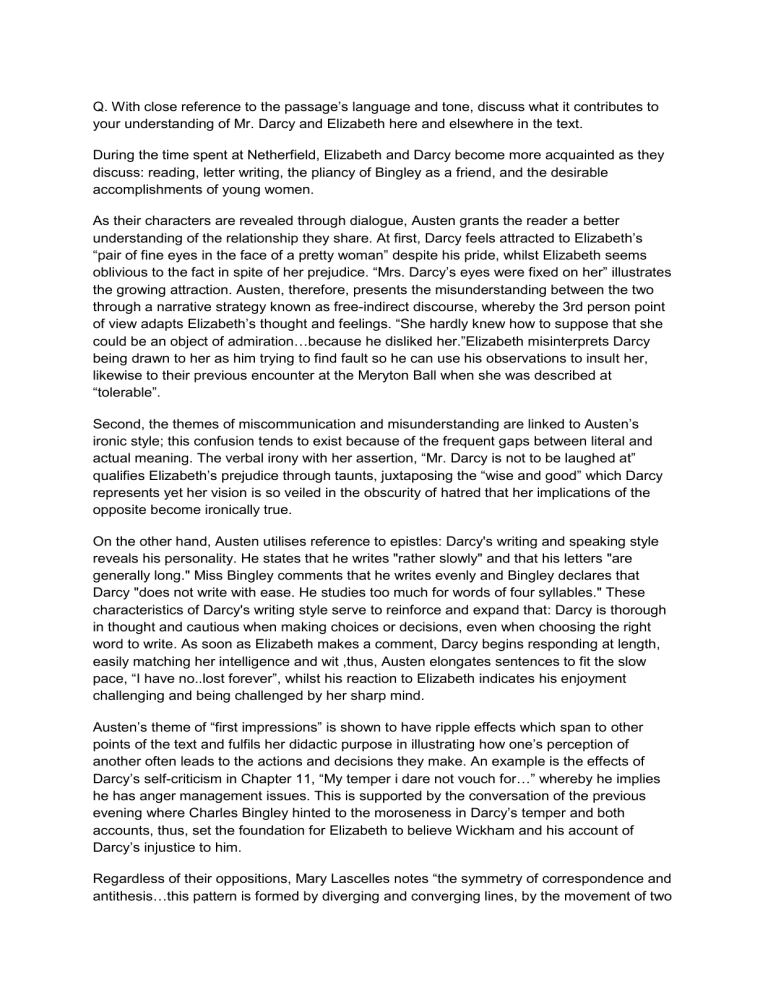
Q. With close reference to the passage’s language and tone, discuss what it contributes to your understanding of Mr. Darcy and Elizabeth here and elsewhere in the text. During the time spent at Netherfield, Elizabeth and Darcy become more acquainted as they discuss: reading, letter writing, the pliancy of Bingley as a friend, and the desirable accomplishments of young women. As their characters are revealed through dialogue, Austen grants the reader a better understanding of the relationship they share. At first, Darcy feels attracted to Elizabeth’s “pair of fine eyes in the face of a pretty woman” despite his pride, whilst Elizabeth seems oblivious to the fact in spite of her prejudice. “Mrs. Darcy’s eyes were fixed on her” illustrates the growing attraction. Austen, therefore, presents the misunderstanding between the two through a narrative strategy known as free-indirect discourse, whereby the 3rd person point of view adapts Elizabeth’s thought and feelings. “She hardly knew how to suppose that she could be an object of admiration…because he disliked her.”Elizabeth misinterprets Darcy being drawn to her as him trying to find fault so he can use his observations to insult her, likewise to their previous encounter at the Meryton Ball when she was described at “tolerable”. Second, the themes of miscommunication and misunderstanding are linked to Austen’s ironic style; this confusion tends to exist because of the frequent gaps between literal and actual meaning. The verbal irony with her assertion, “Mr. Darcy is not to be laughed at” qualifies Elizabeth’s prejudice through taunts, juxtaposing the “wise and good” which Darcy represents yet her vision is so veiled in the obscurity of hatred that her implications of the opposite become ironically true. On the other hand, Austen utilises reference to epistles: Darcy's writing and speaking style reveals his personality. He states that he writes "rather slowly" and that his letters "are generally long." Miss Bingley comments that he writes evenly and Bingley declares that Darcy "does not write with ease. He studies too much for words of four syllables." These characteristics of Darcy's writing style serve to reinforce and expand that: Darcy is thorough in thought and cautious when making choices or decisions, even when choosing the right word to write. As soon as Elizabeth makes a comment, Darcy begins responding at length, easily matching her intelligence and wit ,thus, Austen elongates sentences to fit the slow pace, “I have no..lost forever”, whilst his reaction to Elizabeth indicates his enjoyment challenging and being challenged by her sharp mind. Austen’s theme of “first impressions” is shown to have ripple effects which span to other points of the text and fulfils her didactic purpose in illustrating how one’s perception of another often leads to the actions and decisions they make. An example is the effects of Darcy’s self-criticism in Chapter 11, “My temper i dare not vouch for…” whereby he implies he has anger management issues. This is supported by the conversation of the previous evening where Charles Bingley hinted to the moroseness in Darcy’s temper and both accounts, thus, set the foundation for Elizabeth to believe Wickham and his account of Darcy’s injustice to him. Regardless of their oppositions, Mary Lascelles notes “the symmetry of correspondence and antithesis…this pattern is formed by diverging and converging lines, by the movement of two people..” That is, the characters are shaped to contrast each other until a point of climax which would bring them together in the end. Jane Austen foreshadows this reconciliation by creating similarities shown in the chapters 10 and 11: Jane Austen begins to tighten the threads which link her and Darcy as Elizabeth likes reading whilst Darcy is always buying books. The two, however, “converge” in the Chapters 10 and 11 which ends of with Darcy’s feelings as of the “danger of paying Elizabeth too much attention”. He considers his attraction threatening to his status and detrimental to his own pride and position, thus, the noun ‘danger’. When the two discuss the difference between vanity and pride, Elizabeth ironically represents the former as she is constantly fixated on Darcy's opinion of her. Elizabeth is shown to be teasing to Darcy's seriousness and self-importance which causes an opposite effect and gains Darcy's attraction leading to the following events of unrequitted love as the story progresses. Therefore, Austen employs a style of burlesque to depict the ironic drawbacks of Elizabeth’s scheme to annoy him. In conclusion, the chapters also illustrate the limitations of social class and status which would continuoully keep the 2 characters apart, therefore, Jane Austen presents the difficulties that 2 people face encounters to a long lasting relationship, due to first impressions and misunderstandings.
